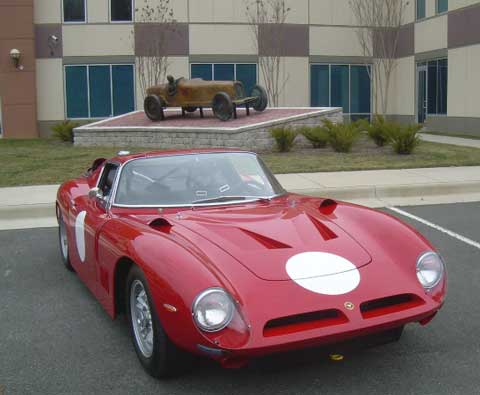
1967 Bizzarini 5300 GT America with chassis number 1A30271.
By Wallace A. Wyss
If ever I had a defining moment it was when I was a young lad. Not a defining moment of the caliber of those little girls in Mexico who saw the Virgin Mary, but it was defining enough that it changed my focus in life.
I was college-age, and in a library looking for books on poetry when I opened a magazine called Autosport and lo and behold there was a story on an odd Italian car called an Iso Grifo A3C. That car later became the basis for what was the Bizzarrini Strada.
I instantly became an Italian car fan in general and a fan of the Bizzarini Strada in particular. In the next few years I gathered material on Bizzarrini and photographed them often and once, for three days, had the pleasure of driving one which I had bought as part of my job as exotic car hunter.
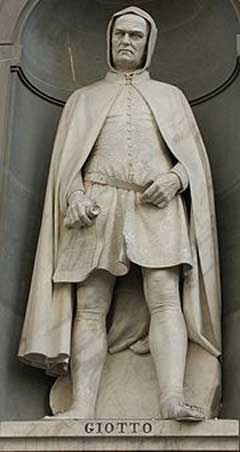
Artist Giotto di Bondone.
The more I read about Ing. Bizzarrini, the more I liked him. You can read all you want about Enzo Ferrari or Ferruccio Lamborghini but the truth is that both men owe a debt to Ing. Bizzarrini, who I’d describe as sort of a “mad scientist†type from Livorno (Leghorn) where he was born in 1926 and given the first name of Giotto by his parents in honor of the famous Italian Renaissance architect and artist (painter) Giotto di Bondone (1267-1337).
It is not surprising that the young Bizzarini took a lot of inspiration from his first name and soon it was evident that he too would be known for his unique creations, the seeds of which were planted when during World War II, he was a prisoner of the Germans and ended up working, where else, but in the army’s motor pool.
It was not until after that war that Bizzarini earned a degree at the University of Pisa (a prestigious school that also saw among its laureates Ing. Carlo Chiti) by constructing a racecar. It was a little car of scrap parts but showed great ingenuity.
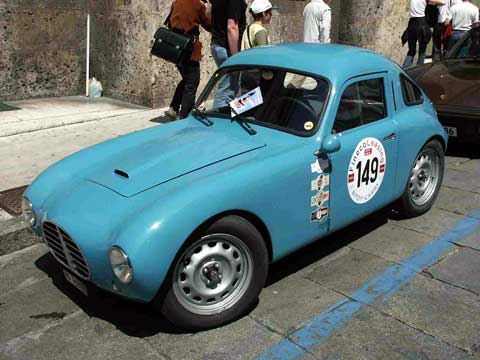
Bizzarrini’s hand-built Fiat based race car, still competing in the Mille Miglia. Photo by Alessandro Gerelli.
Ing. Giotto Bizzarini was never a “company guy†though he worked for Alfa, and later for Ferrari. At Alfa he was in the Experimental Department, employed as a test driver. What made him rather unique was his engineering knowledge which could tell him what and why a car was doing before it grenaded.
He left Alfa Romeo for Ferrari when he heard that a test driver’s death at Ferrari had created an opening. He went there in 1957 and joined the Experimental Department.
When in the early sixties Jaguar came out with the E-type which looked to be very fast and aerodynamic, Enzo Ferrari asked him to come up with a response. At first the response was a faster SWB (short wheel base) berlinetta but Bizzarrini advocated a whole new body. It was while at Ferrari that he created what might have to be called Ferrari’s most memorable street legal race car, the immortal 250 GTO (Gran Turismo Omologato). Now part of the racing department at Ferrari, Bizzarrini took a used SWB chassis (2053GT)* and working in secret at night, he added a long “anteater†nose and kept changing the nose shape for each run on the Autostrada until the elapsed time showed he had some real speed advantage over the SWB. Then he added the SWB Comp car’s six two throat Webers, some Testa Rossa cams and a 5-speed and created the GTO.
Now you would think that the success of the GTO put him on easy street at Ferrari but before the GTO even made its debut Bizzarrini was fired along with other engineers (including Alma Mater companion Ing. Carlo Chiti) who were accused of engineering what was in effect, a “palace revolt.â€
Bizzarrini and three others were then hired by Venice-based Count Giovanni Volpi di Misurata,, who had a racing team called Scuderia Serenissima (read about the Serenissima F1) and who wanted to create a road car that would beat Ferrari’s road cars as well as a Formula 1 car, the latter being driven by Phil Hill and Giancarlo Baghetti, who would be given the same task on the world’s most famous race tracks. But, after an unsuccessful Formula One season the ATS (Automobili Turismo e Sport company, with premises in Casalecchio di Reno near Bologna) fell apart and the production side of the operation never really got going. (read about ATS Sports) Ing. Bizzarrini also worked on the “Ferrarina†or “baby Ferrari†which was sold as the ASA 1000 GT. (read about the ASA)
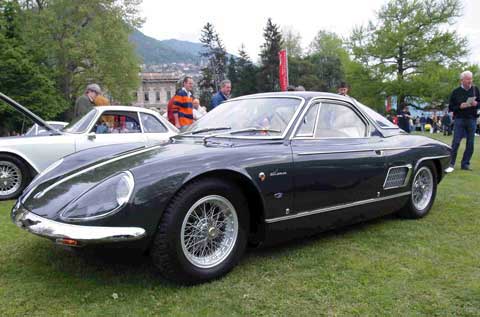
The ATS, thought one of the first mid-engined GTs, never realized full production. Photo by Alessandro Gerelli
As ATS went broke, Bizzarrini went to Lamborghini but his stint was brief. However, it is to be recalled that early in the sixties Ferruccio Lamborghini was a tractor manufacturer who equally wanted to make a car to show up Ferrari. He commissioned Bizzarrini to design a V12 — three liters and 350 horsepower. The story is often told that Bizzarrini would be paid extra for every hp. He delivered over that amount and of course he delivered an engine with 360-370 at 8000 to 9000 rpm.
Ing. Bizzarrini then connected with Milan car manufacturer Comm. Renzo Rivolta, (read about Piero Rivolta) who had made a fortune building refrigerators. He also made the lsetta (diminutive for ISO, and thus little ISO or Isetta) during the time of the Suez crisis, a micro-car that was also built on license by BMW and that played a significant role in the revival of that company.
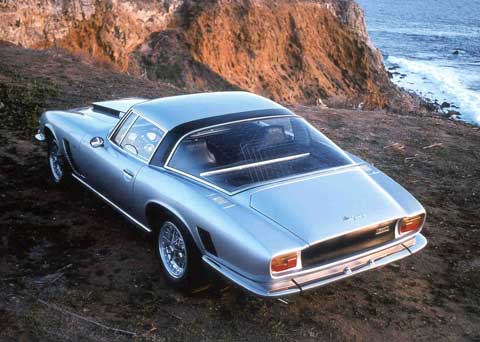
Rivolta and Bizzarrini parted ways and the iso Grifo was built to Rivolta’s more sedate demands. To order this photo click here.
Bizzarrini entered the picture when Renzo Rivolta already had grand plans to build a luxury GT, and had already been working with a Brit, John Gordon, on a four seater car that was to be marketed as the Gordon GT. Rivolta asked Bizzarrini to test drive the Gordon GT prototype but Bizzarrini hated everything about it except the cheap-as-dirt 327 Chevrolet engine — which at the time he realized put out more torque than the famed Ferrari V12s.
Rivolta closed down the negotiations with Gordon, who went on to make the car known as the Gordon-Keeble and Rivolta funded Bizzarrini to design an all new ISO Rivolta four seater. Surprisingly Bizzarrini did not go too exotic with a space frame but instead used mass produced sheet steel for a unitized chassis. After some success with the Rivolta model, including importing it to America, Bizzarrini talked Rivolta into doing a two seater coupe.
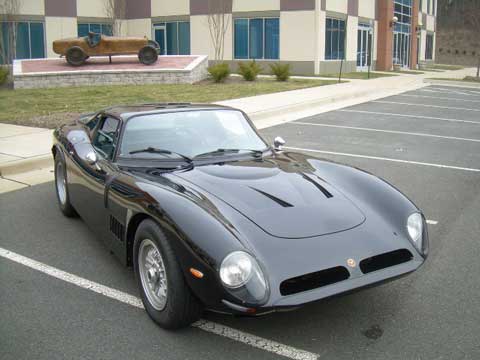
1965 Iso A3/C with chassis number B0216. In 1968, the car was rebodied to Bizzarini specifications as a Bizzarini GT Strada 5300 with Series II dashboard, Weber carburetors and A/C. For sale at www.funktionauto.com.
But Rivolta and Bizzarrini didn’t agree on what a two seater should be like. Bizzarrini had done what came naturally–he built an all-out race car. But to mollify Rivolta, there was also a street version, the A3/L, the L for “Lussoâ€, but Rivolta was not into racing and thought the Lusso was too low and the alloy body too delicate. Rivolta went back to Bertone for a tamer design that could be done in steel, and that became the prototype for the Iso Grifo coupe.
Though the first Iso Grifo race cars (A3/Cs) attained some success, Rivolta made it clear that he was no longer interested in racing. Bizzarrini went back to his native town of Livorno and started producing the first versions under his own name, despite not having any facilities for building the chassis. He was able to do this because of a mistake by Rivolta who had forgotten to register the name “Grifo†under his own company name. Rivolta was forced to “buy†the name back from Bizzarrini by supplying him with unitized chassis for the two seater. at least enough to get the Bizzarrinis rolling out of the Livorno plant.
One of the tricks of making a great front-engined car in what was increasingly becoming a mid-engined era of super-cars was having the engine far back in the front, so far back you had to reach through a hatch in the dash to reach some of the spark plugs.
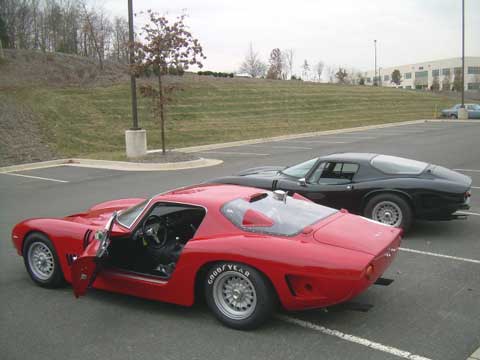
Bizzarrinis next to each other near the site of Funktionauto.
The wheelbase was shortened from the Rivolta four seater and Bizzarrini spread the weight of the gas tanks around with three separate tanks–one on each side of the car and a third behind the two seats (It would hold an incredible 37 gal.!) The well-balanced car had 50.5 percent of the weight in front and 49.5 percent in the rear, without having to be mid-engined which would have meant finding a transaxle.
For the racing version, Bizzarrini also went with four downdraft twin throat Webers in a manifold that either inspired the Corvette Grand Sport manifold or was copied from it. The racing version was rated at 405 bhp at 5400 rpm, which was about 15 more horses than Shelby could squeeze out of a 4.7 liter Cobra V8.
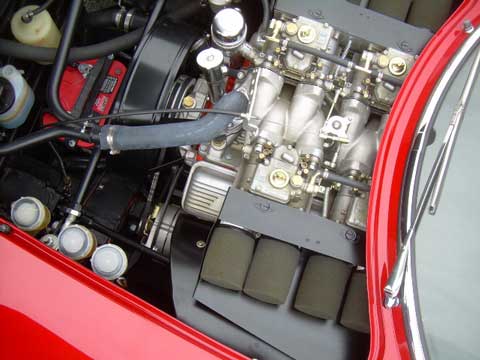
Bizzarrini excelled in putting the engine into the driver’s compartment.
The first A3/C body had been built by Piero Drogo of the famed Sports Cars Modena, the chassis welded together but the aluminum body was tacked on by thousands of rivets to hold it all together. One historian says Bizzarrini called the first cars “Bizzarrini Grifos†but this author has only heard the names “5300 Strada†, Stradale 5300 and “GT America†attached to the versions from Livorno. At some point he switched to fiberglass bodies and there was even a surprisingly agile looking “baby Bizzarrini,†that was somewhat reminiscent of the larger Bizzarinis; this little Bizzarini, called the Europa, used a highly tuned Opel four cylinder.
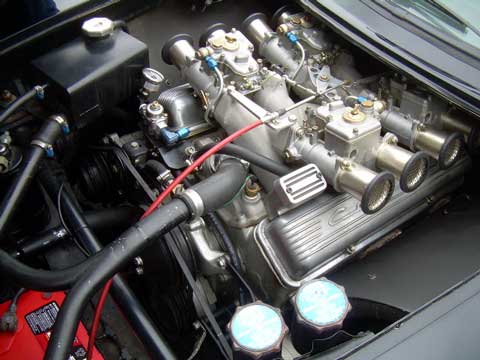
By now, all versions probably have the four Weber set up on at least a 327 inch Chevy.
Bizzarinis are “Arte Artigianale†as stated in Italian terms, which means that each one of these cars is hand-crafted and in effect a piece of individual art resulting from the skills of craftsmen. No two Bizzarrinis are exactly alike and as a consequence the bodyworks of the Bizzarrinis are not the greatest on quality. One reason behind this is that, if you see the factory pictures, you see a lot of wine bottles on the shelves as the cars are hand built. Maybe some days they finished two bottles of wine while working on the cars, and on other days three. The cars had a lot of flaws – cockpit heat, bad brakes in the early cars, a horrible instrument layout in the first series, and on and on. And the 327 engine wasn’t really reliable, they needed American tuning parts to get much past 5500 rpm (though one could argue the small block Chevy was more reliable than the 289 Ford Shelby was using in the Cobra).
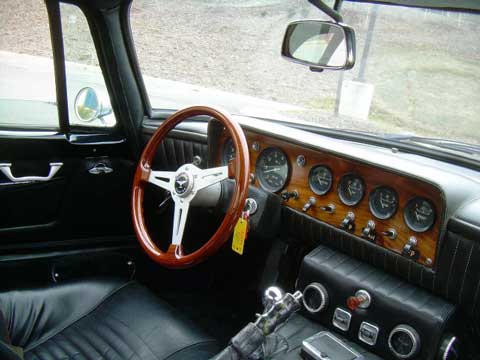
Bizzarini GT Strada 5300 with Series II dashboard.
It is confusing how many Bizzarinis left the premises in Livorno. Most will agree that Bizzarini made at least 100 but there were times when he didn’t have to pay a tax if he could re-use an already existent serial number so some cars out there do have identical SN’s. Not to mention that a local body shop in Italy whacked out a few more Bizzarinis decades later when the Americans re-discovered the car. Genny Obert, (read about Obert) the late and well respected historian, estimated that “Only about 25 Iso Grifo A3/Cs were built before Bizzarrini took over production in 1965, and something between 135 and 155 Bizzarrini Stradas and GT Americas (sources vary) were completed before Bizzarrini moved on to other things after 1969 .â€
There were even some oddball body styles knocked out on occasion, like a one-off two plus two, and two or three targas (called SI models), and then there was a full roadster which Road & Track pictured and said was unfinished but which nevertheless has been seen recently in complete form at Concorso Italiano.
There was brief foray into mid-engined cars, one built into a full- on race car coupe for Count D’Aosta and several roadsters, some of which were Lamborghini V-12 powered. Why an exotic Lambo when he could get Chevy engines much cheaper? Hey, it wasn’t exotic to him–he designed the Lamborghini V-12. (read about Lambo-Bizzarrini)
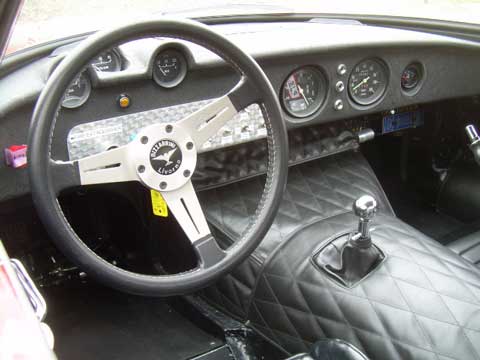
A bit more of a spartan look to the interior of the red Bizzarrini at Funktionauto.
And so it goes, in the world of exotic cars, you have your purebred cars from Italy where the engines are made by the firms that also produce the car, and then you get your not-so-pure-but-still-goddam fast hybrids with cast iron pushrod lumps from the U.S. under the hood. I prefer the latter because power is power no matter where it comes from. One thing great about all the exotic cars from Italy that used American V8 engines is that, in the early days of restoration before Pebble Beach standards became the expected norm, you could save so much on restoring the engine, the money saved would pay for much of the restoration of the rest of the car.
Our thanks to the folks at www.funktionauto.com.
*Ferrari GTO, Bluemel, Pourrett, page 22
Wally, I would love to hear from you. You once did a rather long article in an Australian magazine about my white Bizzarrini.I have a group of negatives of dozens of pictures that you took of my car. Very nice article on Mr Bizzarrini!
Wally,
This is a really well-written article. I am impressed. Good work.
Brandy Elitch
Thanks Mr. Wyss, at last now I get it how Iso and Bizzarrini are/were related. On question, though. I have never found proof of who designed the shape of the Bizza Strada. Could this be Giugiaro, while working at Bertone? He did the Grifo there, anyway.
Kind Regards,
Bart van den Acker
freelance automotive journalist
The first Bizzarrini raced at Sebring was driven by Tulsa’s then-budget director and Irene Castle’s son, Bill McLaughlin. When they took the engine apart (I can’t remember if it was before or after the race) it had two different sizes of pistons in it. Bill Pryor and I met Sig. B. at his shop in Livorno that wonderful summer of ’66. Really nice guy, with stuff for sale cheap (we got bored with all the stuff that was for sale cheap in Italy then–what ninnies we were). I got a B. under odd circumstances. It was geared for about 37mph/1000rpm: great mileage! The fuel gauge was amusing. It went from full to empty as the 10gal. tank behind the seats drained, but the warning light didn’t come on until you’d used most of the remaining 20-odd gallons in the side tanks. I could go on and on…
There is a drawing of the front view of the Strada signed by Giugiaro in one of the Italian design magazines (probably Stile Auto, long out of print) , so that’s proof he designed it while a young man at Carrozzeria Bertone. He also designed the prototype and production Iso Grifo. But I never did find out who designed the P528 mid-engined car which I find aesthetically less pleasing–that looks more like engineer Bizzarrini pieced that one together himself. I also never found out if Giugiaro designed the “baby Bizzarrini” but consider that a less successful design, sort of a condensed version of the Strada without the grace of the big ‘un.
Mr. Wyss, I have been rolling around an idea for a book completely dedicated to the sire of the V-8 Ferrari street car, the gt4. What do you think? From several different perspectives the 308 gt4 is a unique and trendseting Ferrari that has always been treated like a red-headed step child.
Thomas Gonnella
I think the GT4 is an interesting car, not as collectible as the 308GTB/GTS but if you want advice on writing a book or publishing it yourself (I have worn both hats) feel free to contact me at photojournalistpro@hotmail.com
From what Ing. Bizzarrini has created and achieved in his life it is obvious that he always was connected with car dynamics, behaviour, chassis and suspension design.
With one exeption: he has been credited with the paternity of the first Lamborghini engine, too. A clean and honest V12, the lay-out of which as a whole and in details clearly shows the thinking of a well-experienced designer who knew his basics, from a mechanical and thermodynamical point of view (I know this first series engine quite well, as I do Ferrari’s V12s, too).
Ing. Bizzarrini never designed another engine, neither before nor after this Lambo period. The question was and is: who REALLY designed the basic Lamborghini engine???
http://www.rmauctions.com/lots/lot.cfm?lot_id=1072299
When quality is there, result follow